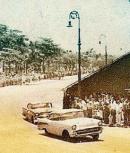ROLANDO CAÑEDO
Car races stopped in Cuba in the early 1960s. There are racers from that time who never left motoring behind and kept on practicing the four-wheel sport in different ways. We now shed light on one of the winners from that time, those that are still in the memory of some people and there are many interested in learning from them.
Cañedo speaks about motor racing in Cuba as one of its major figures, collaborators and activists for over half a century. These are the memories of a Cuban racer.
Rolando first sat behind a wheel at the age of 12. He hadn’t seen any race and he was already “going hard” around the curves.
RC: The first races I witnessed were held from Pinar del Rio to Havana, back in 1955, when I was 16 years old.
ExM: What was your first race and how did you cultivate passion for motoring?
RC: After the triumph of the 1959 Revolution, I raced in the Libertad Grand Prix in Havana. The race took place at the runway of a military facility airport, which later became a school. It was an international race that counted on the participation of the top drivers at the time, such as UK’s Stirling Moss, the world’s number-two seed. There were other races: GP Alamar, I raced and I won it. At GP ICP (Cuban Petroleum Institute), 26th Avenue, I finished first, but my car broke down in the last lap. I didn’t get the prize, but I won the people’s hearts. However, my best circuitever was down the Port Avenue, where I defeated the finest drivers of the moment, such as El Gallego (Rafael Cabrera) and Abelardo Carreras. Since the beginning of my racing career through the end of motor racing, I was ranked third twice, got a second position and nabbed three titles.
ExM: What happened when car racing was over?
RC: Then we had the karts. My friend Pancho (Francisco) Abascal had one. The Association of Patriotic Military Education (SEPMI is the Spanish acronym) supported karting and we started racing. There were two categories: Junior and Master. I won the Master for five years running. The karts were made by us, with motorcycle engines and makeshift bodies. But in the 1990s, a Grand Prix was organized with ELF (French Petroleum Company) in Malecon and they donated karts to keep developing that racing sport in Cuba. The turn of the new millennium was the golden age of karting. A circuit was built in El Salado Beach and there were many teams sponsored by foreign companies.
ExM: What’s your present role in the karting realm?
RC: The number of races has dropped, but I still support this sport. I visit karting schools for children and share my experiences with them, kid who race with karts donated by FIA (International Motoring Federation). Excellent pilots have been trained there, some of which have already competed overseas.
ExM: What do you do for a living right now?
RC: I’m a senior specialist with SASA (Automobile Services S.A.). I’ve spent 60 of my 76 years of life in workshops. And I’m still there.
ExM: Thanks, champion.


































































































